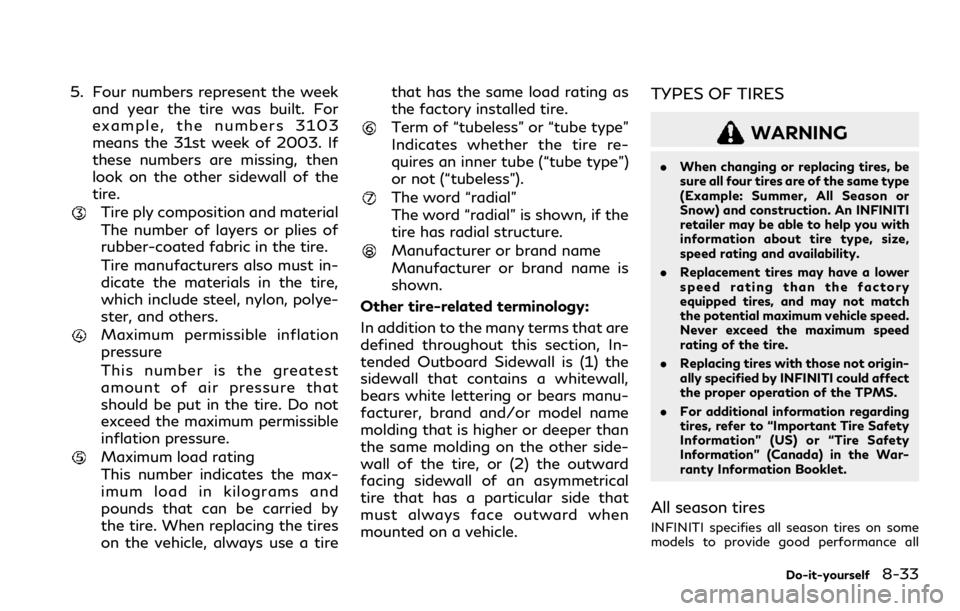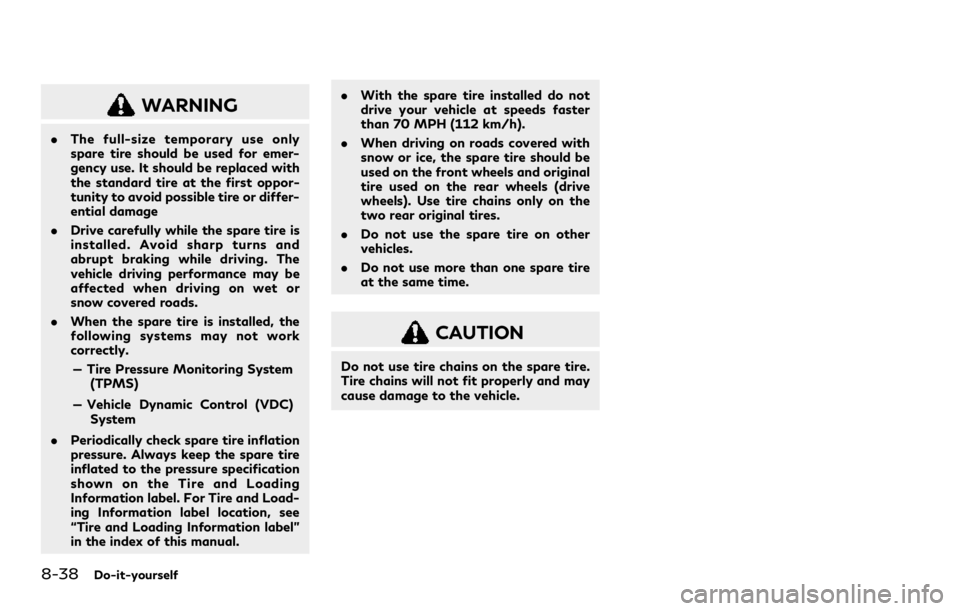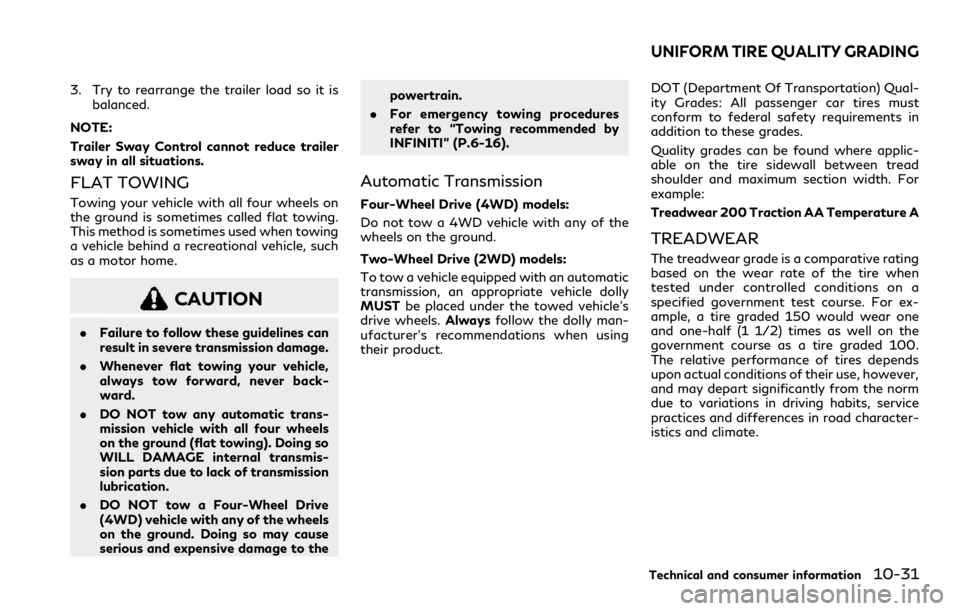flat tire INFINITI QX80 2021 Owner's Guide
[x] Cancel search | Manufacturer: INFINITI, Model Year: 2021, Model line: QX80, Model: INFINITI QX80 2021Pages: 529, PDF Size: 2.05 MB
Page 453 of 529

8-30Do-it-yourself
SDI1949
Checking the tire pressure
1. Remove the valve stem cap fromthe tire.
2. Press the pressure gauge squarely onto the valve stem. Do not press
too hard or force the valve stem
sideways, or air will escape. If the
hissing sound of air escaping from
the tire is heard while checking the
pressure, reposition the gauge to
eliminate this leakage.
3. Remove the gauge. 4. Read the tire pressure on the
gauge stem and compare it to the
specification shown on the Tire
and Loading Information label.
5. Add air to the tire as needed. If too much air is added, press the core of
the valve stem briefly with the tip
of the gauge stem to release
pressure. Recheck the pressure
and add or release air as needed.
6. Install the valve stem cap.
7. Check the pressure of all other tires, including the spare.
8. Check the pressure when driving the vehicle at speeds of 100 mph
(160 km/h) or higher where it is
legal to do so.
WARNING
. Driving at high speeds, 100 mph (160
km/h) or higher sustained where it is
legal to do so, can cause tires to have
excessive heat build up, which may
result in a tire failure causing loss of
control, crash, injuries or even death.
Some high-speed rated tires require inflation pressure adjustment for
high-speed operation. When speed
limits and road conditions allow ve-
hicle driving at high speeds, make
sure tires are rated to support high
speed operation, tires are in optimal
conditions and pressure is adjusted to
correct cold inflation pressure for
high speed operation.
. Tires require adjustment to the infla-
tion pressure when driving the vehicle
at speeds of 100 mph (160 km/h) or
higher where it is legal to do so. See
recommended tire inflation chart for
correct operating pressure.
. After vehicle high speed operation
has ended, readjust the tire pressure
to the recommended cold inflation
pressure. (See “Checking the tire
pressure” (P.8-30).)
Page 454 of 529

SizeCold Tire In-
flation Pres- sure
Front Original Tire:
P275/50R22 111H 35 psi, 240
kPa
Front Original Tire:
P275/60R20 114H 35 psi, 240
kPa
Rear Original Tire:
P275/50R22 111H 35 psi, 240
kPa
Rear Original Tire:
P275/60R20 114H 35 psi, 240
kPa
Spare Tire:
275/60R20 115M 35 psi, 240
kPa
Spare Tire:
265/70R18 116M 51 psi, 350
kPa
Recommended tire inflation pressures at
speeds of 100 mph (160 km/h) or higher
where it is legal to do so.
SizeCold Tire In-
flation Pres- sure
Front Original Tire:
P275/50R22 111H 41 psi, 280
kPa
Front Original Tire:
P275/60R20 114H 36 psi, 250
kPa
Rear Original Tire:
P275/50R22 111H 41 psi, 280
kPa
Rear Original Tire:
P275/60R20 114H 36 psi, 250
kPa
SDI1575
Example
TIRE LABELING
Federal law requires tire manufac-
turers to place standardized informa-
tion on the sidewall of all tires. This
information identifies and describes
the fundamental characteristics of
the tire and also provides the tire
identification number (TIN) for safety
standard certification. The TIN can be
used to identify the tire in case of a
recall.
Do-it-yourself8-31
Page 456 of 529

5. Four numbers represent the weekand year the tire was built. For
example, the numbers 3103
means the 31st week of 2003. If
these numbers are missing, then
look on the other sidewall of the
tire.
Tire ply composition and material
The number of layers or plies of
rubber-coated fabric in the tire.
Tire manufacturers also must in-
dicate the materials in the tire,
which include steel, nylon, polye-
ster, and others.
Maximum permissible inflation
pressure
This number is the greatest
amount of air pressure that
should be put in the tire. Do not
exceed the maximum permissible
inflation pressure.
Maximum load rating
This number indicates the max-
imum load in kilograms and
pounds that can be carried by
the tire. When replacing the tires
on the vehicle, always use a tire that has the same load rating as
the factory installed tire.
Term of “tubeless” or “tube type”
Indicates whether the tire re-
quires an inner tube (“tube type”)
or not (“tubeless”).
The word “radial”
The word “radial” is shown, if the
tire has radial structure.
Manufacturer or brand name
Manufacturer or brand name is
shown.
Other tire-related terminology:
In addition to the many terms that are
defined throughout this section, In-
tended Outboard Sidewall is (1) the
sidewall that contains a whitewall,
bears white lettering or bears manu-
facturer, brand and/or model name
molding that is higher or deeper than
the same molding on the other side-
wall of the tire, or (2) the outward
facing sidewall of an asymmetrical
tire that has a particular side that
must always face outward when
mounted on a vehicle.
TYPES OF TIRES
WARNING
. When changing or replacing tires, be
sure all four tires are of the same type
(Example: Summer, All Season or
Snow) and construction. An INFINITI
retailer may be able to help you with
information about tire type, size,
speed rating and availability.
. Replacement tires may have a lower
speed rating than the factory
equipped tires, and may not match
the potential maximum vehicle speed.
Never exceed the maximum speed
rating of the tire.
. Replacing tires with those not origin-
ally specified by INFINITI could affect
the proper operation of the TPMS.
. For additional information regarding
tires, refer to “Important Tire Safety
Information” (US) or “Tire Safety
Information” (Canada) in the War-
ranty Information Booklet.
All season tires
INFINITI specifies all season tires on some
models to provide good performance all
Do-it-yourself8-33
Page 458 of 529

SDI1662
CHANGING WHEELS AND TIRES
Tire rotation
INFINITI recommends rotating the
tires every 7,500 miles (12,000 km).
(See “Flat tire” (P.6-3) for tire repla-
cing procedures.)
As soon as possible, tighten the
wheel nuts to the specified torque
with a torque wrench.Wheel nut tightening torque:98 ft-lb (133 N·m)
The wheel nuts must be kept tigh- tened to the specification at all times.
It is recommended that wheel nuts be
tightened to the specification at each
tire rotation interval.
WARNING
.
After rotating the tires, check
and adjust the tire pressure.
. Retighten the wheel nuts when
the vehicle has been driven for
600 miles (1,000 km) (also in
cases of a flat tire, etc.).
. Do not include the full-size
temporary use only spare tire
(if so equipped) in the tire
rotation.
. For additional information re-
garding tires, refer to “Impor-
tant Tire Safety Information”
(US) or “Tire Safety Informa-
tion” (Canada) in the Warranty
Information Booklet.
SDI1663
1.Wear indicator
2.Wear indicator location mark
Tire wear and damage
WARNING
.Tires should be periodically in-
spected for wear, cracking, bul-
ging or objects caught in the
tread. If excessive wear, cracks,
bulging or deep cuts are found,
the tire(s) should be replaced.
. The original tires have built-in
Do-it-yourself8-35
Page 461 of 529

8-38Do-it-yourself
WARNING
.The full-size temporary use only
spare tire should be used for emer-
gency use. It should be replaced with
the standard tire at the first oppor-
tunity to avoid possible tire or differ-
ential damage
. Drive carefully while the spare tire is
installed. Avoid sharp turns and
abrupt braking while driving. The
vehicle driving performance may be
affected when driving on wet or
snow covered roads.
. When the spare tire is installed, the
following systems may not work
correctly.
— Tire Pressure Monitoring System (TPMS)
— Vehicle Dynamic Control (VDC) System
. Periodically check spare tire inflation
pressure. Always keep the spare tire
inflated to the pressure specification
shown on the Tire and Loading
Information label. For Tire and Load-
ing Information label location, see
“Tire and Loading Information label”
in the index of this manual. .
With the spare tire installed do not
drive your vehicle at speeds faster
than 70 MPH (112 km/h).
. When driving on roads covered with
snow or ice, the spare tire should be
used on the front wheels and original
tire used on the rear wheels (drive
wheels). Use tire chains only on the
two rear original tires.
. Do not use the spare tire on other
vehicles.
. Do not use more than one spare tire
at the same time.
CAUTION
Do not use tire chains on the spare tire.
Tire chains will not fit properly and may
cause damage to the vehicle.
Page 482 of 529

10 Technical and consumer information
Capacities and recommended fluids/lubricants ..... 10-2Fuel information ....................................................... 10-4
Engine oil and oil filter recommendation ........... 10-6
Air conditioning system refrigerant and
oil recommendations ................................................ 10-7
Specifications .................................................................. 10-8
Engine ........................................................................\
.. 10-8
Wheels and tires ........................................................ 10-9
Dimensions ............................................................... 10-10
When traveling or registering in
another country ............................................................. 10-11
Vehicle identification ................................................... 10-11 Vehicle Identification Number (VIN) plate ....... 10-11
Vehicle identification number
(chassis number) ...................................................... 10-11
Engine serial number ............................................. 10-12
F.M.V.S.S./C.M.V.S.S. certification label ........ 10-12
Emission control information label ................... 10-12
Tire and loading information label .................... 10-13
Air conditioner specification label ..................... 10-13
Installing front license plate ..................................... 10-15
Vehicle loading information ...................................... 10-15 Terms ........................................................................\
. 10-15 Vehicle load capacity ........................................... 10-17
Securing the load ................................................. 10-18
Loading tips ........................................................... 10-18
Measurement of weights ................................... 10-19
Towing a trailer ........................................................... 10-19 Maximum load limits ........................................... 10-19
Maximum Gross Vehicle Weight (GVW)/
maximum Gross Axle Weight (GAW) ............. 10-21
Towing load/specification ................................. 10-22
Towing safety ....................................................... 10-23
Flat towing ............................................................. 10-31
Uniform tire quality grading .................................... 10-31 Treadwear .............................................................. 10-31
Traction AA, A, B and C ..................................... 10-32
Temperature A, B and C .................................... 10-32
Emission control system warranty ......................... 10-32
Reporting safety defects .......................................... 10-33
Readiness for Inspection/Maintenance
(I/M) test ....................................................................... 10-34
Event Data Recorders (EDR) ................................... 10-35
Owner’s Manual/Service Manual
order information ........................................................ 10-35
Page 498 of 529

VEHICLE LOAD CAPACITY
Do not exceed the load limit of your
vehicle shown as “The combined
weight of occupants and cargo” on
the Tire and Loading Information
label. Do not exceed the number of
occupants shown as “Seating Capa-
city” on the Tire and Loading Infor-
mation label.
To get “the combined weight of
occupants and cargo”, add the weight
of all occupants, then add the total
luggage weight. Examples are shown
in the illustration.
Steps for determining correct load
limit
1. Locate the statement “The com-bined weight of occupants and
cargo should never exceed XXX
kg or XXX lbs” on your vehicle’s
placard.
2. Determine the combined weight of the driver and passengers that will
be riding in your vehicle.
3. Subtract the combined weight of the driver and passengers from
XXX kg or XXX lbs.
4. The resulting figure equals the available amount of cargo and
luggage load capacity. For exam-
ple, if the XXX amount equals
1400 lbs. and there will be five
150 lb. passengers in your vehicle,
the amount of available cargo and
luggage load capacity is 650 lbs.
(1400 − 750 (5 x 150) = 650 lbs) or
(640 − 340 (5 x 70) = 300 kg.)
5. Determine the combined weight of luggage and cargo being loaded on
the vehicle. That weight may not
safely exceed the available cargo
and luggage load capacity calcu-
lated in Step 4.
6. If your vehicle will be towing a trailer, load from your trailer will
be transferred to your vehicle.
Consult this manual to determine
how this reduces the available
cargo and luggage load capacity
of your vehicle.
Before driving a loaded vehicle, con-
firm that you do not exceed the Gross Vehicle Weight Rating (GVWR) or the
Gross Axle Weight Rating (GAWR)
for your vehicle. (See “Measurement
of weights” (P.10-19).)
Also check tires for proper inflation
pressures. See the Tire and Loading
Information label.
Technical and consumer information10-17
Page 507 of 529

10-26Technical and consumer information
measured reference height when loaded,
the vehicle may handle unpredictably
which could cause a loss of vehicle
control and cause serious personal injury
or property damage.
Sway control device
Sudden maneuvers, wind gusts and buffet-
ing caused by other vehicles can affect
trailer handling. Sway control devices may
be used to help control these affects. If you
choose to use one, contact a reputable
trailer hitch supplier to make sure the sway
control device will work with the vehicle,
hitch, trailer and the trailer’s brake system.
Follow the instructions provided by the
manufacturer for installing and using the
sway control device.
Class I hitch
Class I trailer hitch equipment (receiver, ball
mount and hitch ball) can be used to tow
trailers of a maximum weight of 2,000 lb
(907 kg).
Class II hitch
Class II trailer hitch equipment (receiver, ball
mount and hitch ball) can be used to tow
trailers of a maximum weight of 3,500 lb
(1,588 kg).
Class III hitch
Class III trailer hitch equipment (receiver, ball
mount and hitch ball) can be used to tow
trailers of a maximum weight of 5,000 lb
(2,267 kg).
Class IV hitch
Class IV trailer hitch equipment (receiver, ball
mount and hitch ball) can be used to tow
trailers of a maximum weight of 10,000 lb
(4,545 kg). A weight distributing hitch
should be used to tow trailers that weigh
over 5,000 lb (2,267 kg).
Your vehicle may be equipped with Class IV
trailer hitch equipment that has a 10,000 lb
(4,545 kg) maximum weight rating, but your
vehicle is only capable of towing the max-
imum trailer weights shown in the “Towing
Load/Specification” chart earlier in this
section.
CAUTION
.Do not use axle-mounted hitches.
. Do not modify the vehicle exhaust
system, brake system, etc.
. Do not attach any additional hitches
to your vehicle because a hitch is
already mounted to your vehicle frame.
Tire pressures
.
When towing a trailer, inflate the
vehicle tires to the recommended
cold tire pressure indicated on the
Tire and Loading Information la-
bel.
. Trailer tire condition, size, load
rating and proper inflation pres-
sure should be in accordance with
the trailer and tire manufacturers’
specifications.
Safety chains
Always use a suitable chain between your
vehicle and the trailer. The safety chains
should be crossed and should be attached to
the hitch, not to the vehicle bumper or axle.
Be sure to leave enough slack in the chains to
permit turning corners.
Page 512 of 529

3. Try to rearrange the trailer load so it isbalanced.
NOTE:
Trailer Sway Control cannot reduce trailer
sway in all situations.
FLAT TOWING
Towing your vehicle with all four wheels on
the ground is sometimes called flat towing.
This method is sometimes used when towing
a vehicle behind a recreational vehicle, such
as a motor home.
CAUTION
. Failure to follow these guidelines can
result in severe transmission damage.
. Whenever flat towing your vehicle,
always tow forward, never back-
ward.
. DO NOT tow any automatic trans-
mission vehicle with all four wheels
on the ground (flat towing). Doing so
WILL DAMAGE internal transmis-
sion parts due to lack of transmission
lubrication.
. DO NOT tow a Four-Wheel Drive
(4WD) vehicle with any of the wheels
on the ground. Doing so may cause
serious and expensive damage to the powertrain.
. For emergency towing procedures
refer to “Towing recommended by
INFINITI” (P.6-16).
Automatic Transmission
Four-Wheel Drive (4WD) models:
Do not tow a 4WD vehicle with any of the
wheels on the ground.
Two-Wheel Drive (2WD) models:
To tow a vehicle equipped with an automatic
transmission, an appropriate vehicle dolly
MUST be placed under the towed vehicle’s
drive wheels. Alwaysfollow the dolly man-
ufacturer’s recommendations when using
their product. DOT (Department Of Transportation) Qual-
ity Grades: All passenger car tires must
conform to federal safety requirements in
addition to these grades.
Quality grades can be found where applic-
able on the tire sidewall between tread
shoulder and maximum section width. For
example:
Treadwear 200 Traction AA Temperature A
TREADWEAR
The treadwear grade is a comparative rating
based on the wear rate of the tire when
tested under controlled conditions on a
specified government test course. For ex-
ample, a tire graded 150 would wear one
and one-half (1 1/2) times as well on the
government course as a tire graded 100.
The relative performance of tires depends
upon actual conditions of their use, however,
and may depart significantly from the norm
due to variations in driving habits, service
practices and differences in road character-
istics and climate.
Technical and consumer information10-31
UNIFORM TIRE QUALITY GRADING
Page 513 of 529

10-32Technical and consumer information
TRACTION AA, A, B AND C
The traction grades, from highest to lowest,
are AA, A, B and C. Those grades represent
the tire’s ability to stop on wet pavement as
measured under controlled conditions on
specified government test surfaces of as-
phalt and concrete. A tire marked C may
have poor traction performance.
WARNING
The traction grade assigned to this tire is
based on straight-ahead braking trac-
tion tests, and does not include accel-
eration, cornering, hydroplaning, or peak
traction characteristics.
TEMPERATURE A, B AND C
The temperature grades A (the highest), B,
and C, representing the tire’s resistance to
the generation of heat and its ability to
dissipate heat when tested under controlled
conditions on a specified indoor laboratory
test wheel. Sustained high temperature can
cause the material of the tire to degenerate
and reduce tire life, and excessive tempera-
ture can lead to sudden tire failure. The
grade C corresponds to a level of perfor-
mance which all passenger car tires must
meet under the Federal Motor VehicleSafety Standard No. 109. Grades B and A
represent higher levels of performance on
the laboratory test wheel than the minimum
required by law.
WARNING
The temperature grade for this tire is
established for a tire that is properly
inflated and not overloaded. Excessive
speed, under-inflation, or excessive
loading, either separately or in combina-
tion, can cause heat build-up and possi-
ble tire failure.
Your INFINITI is covered by the following
emission warranties.
For USA:
.
Emission Defects Warranty
. Emissions Performance Warranty
Details of these warranties may be found
with other vehicle warranties in your War-
ranty Information Booklet that comes with
your INFINITI. If you did not receive a
Warranty Information Booklet, or it has
become lost, you may obtain a replacement
by writing to:
. INFINITI Division
Nissan North America, Inc.
Consumer Affairs Department
P.O. Box 685003
Franklin, TN 37068-5003
For Canada:
Emission Control System Warranty
Details of these warranties may be found
with other vehicle warranties in your War-
ranty and Roadside Assistance Information
that comes with your INFINITI. If you did not
receive a Warranty and Roadside Assistance
Information, or it has become lost, you may
obtain a replacement by writing to:
. Nissan Canada Inc.
5290 Orbitor Drive
Mississauga, Ontario,
EMISSION CONTROL SYSTEM
WARRANTY